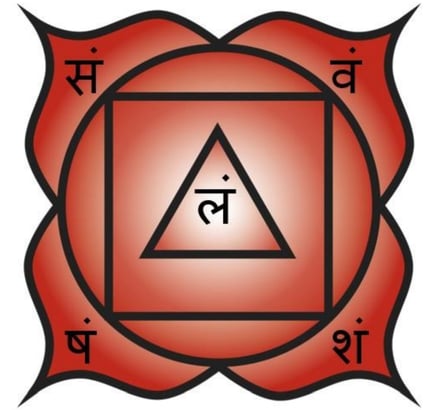"Activating the Muladhara - Root Chakra."
The Muladhara chakra sits at the base of the spinal cord and is symbolized by the color red. Tapping into this chakra encourages the Tamo guna to take the forefront, which can immerse our minds in material preoccupations—such as our desires, attachments, ego, and even feelings of anger.


The Muladhara chakra, often known as the root chakra, sits at the base of our spinal cord and is linked to the color red. When we engage with this chakra, the Tamo guna takes precedence, steering our thoughts toward earthly matters like desires, attachments, ego, and even anger. This connection can sometimes evoke feelings of insecurity and self-pity, causing us to see our surroundings as less than safe. Despite this challenging aspect, it's essential to work through this chakra to elevate ourselves to higher levels. As we've previously discussed in "The Inner Voice," we touched upon the first steps for guiding the kundalini energy from the perineum to the Muladhara. Now, let’s shift our focus to retaining this energy within the Muladhara for a while. To enrich our practice, we'll introduce an additional exercise. It's important to have a knowledgeable Guru by your side during these practices, as doing them improperly can adversely affect your nervous system. Start by finding a comfortable seated position with your spine erect. Tilt your head slightly back and draw your shoulders back to open up your armpits. Take a few moments to breathe normally and settle into this position. Then, practice rapid breathing through your nose for multiple cycles, making sure your stomach expands with each inhale and contracts with every exhale. After this, ease back into your normal breath and take a moment to relax.
Start by taking a deep breath. Engage moolabhandha, expand your stomach, and gently tilt your head back. Hold your breath for a few seconds, allowing your comfort level to guide how long you do so. Remember, it's not necessary to hold your breath for too long as prolonged breath-holding can cause discomfort and disrupt your breathing rhythm. After a few moments, exhale slowly and steadily while releasing moolabhandha, draw your stomach in, and bend your head forward until your chin touches your chest. Remain in this position for a moment before returning to a neutral stance. As you repeat the inhalation process, holding your breath for a few seconds each time, visualize the kundalini energy moving from your perineum to your coccyx. After completing several rounds of this breathing technique, take a brief moment to relax and sit in stillness. Focus your meditation on the coccyx area, imagining the kundalini energy as a deep red color. If you feel the energy activate in this region, you may detect a pulsation that you can feel by placing your hand on your coccyx. This area will feel warmer than the perineum, signaling that your kundalini energy has risen to the base or root chakra, also known as the muladhara chakra. Gently close your eyes and continue meditating, concentrating on this vibrant red chakra. In time, you may find the red color surrounding you. Once this hue becomes evident, immerse yourself in it for a moment. Then, visualize the kundalini energy returning to its original place at the perineum. You’ll notice the pulsation in the coccyx decrease as the energy descends back, with the red color gradually fading. The warmth you felt in the coccyx will shift to the perineum. You have successfully awakened the kundalini, allowing it to reside temporarily in the base chakra before guiding it back to its starting point at the perineum.
